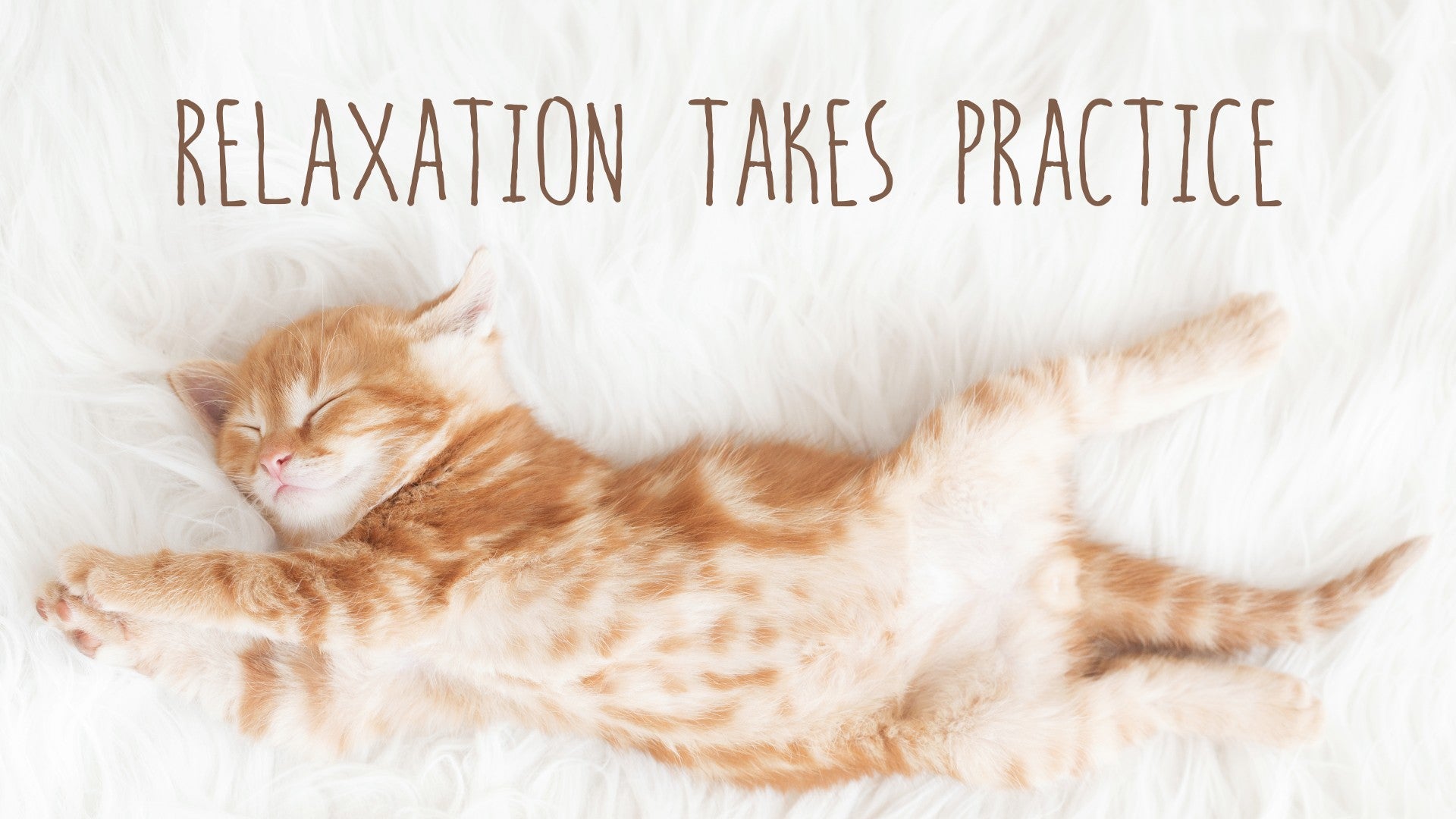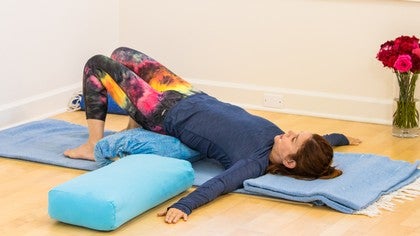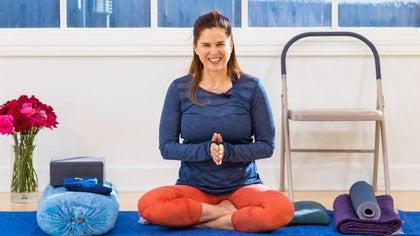Description
About This Video
Transcript
Read Full Transcript
Greetings everyone. Thanks for joining me here today. Today I'm gonna be talking about how you can be successful at integrating restorative yoga. Either into your practice or into the classes that you teach. What I've noticed over the years that I've been teaching teachers how to teach restorative yoga, that there are a couple of different reasons why they want to do it.
And one of the reasons I find most fascinating is just their curiosity. This element of curiosity about being on the mat in a very unique way. I think this is far and foremost the most important of elements to integrating this into your teaching. And the reason I'm saying that is that there is a level of curiosity that is needed that goes beyond seeking sensation in the asanas. Let's admit it, we all love to feel good when we're in a pose.
That's not to say that being in a restorative yoga pose doesn't elicit that same feeling. It's just a lot quieter. It's softer. It's a little more subtle. So in order to do this, I've put together a couple of steps that I can think you can be successful at.
And let me start with the first one. The first one is knowing where to put that restorative pose in your class. You have a couple of options. First is at the top of the class. Second is after all of the sort of work phase.
And the third is either at the end of the cooling phase or even as a Shavasana pose as well. It could be totally supported. So let's go back to the first one and talk about that a little bit. Let's say you've designed a class and now you wanna put that restorative pose at the beginning of the class. I suggest that you put a restorative pose in the beginning of a class that also ties into the rest of the class that you're teaching.
Maybe you're the kind of teacher that builds up to a specific pose. If that's the case, and let's say you're building up to back bends that day, then maybe a soft back bend is an appropriate choice. Meaning that you put them in a pose where they can feel what it feels like to the least amount of effort in a back bend. And that's exactly what would happen if you put 'em in the right pose. Another thing is if you put them in a pose that elicits some kind of feeling in them, it will change how they practice throughout the time on the mat.
It's true, it will change. When you come into the class, you sit down, what's the first thing you do? You take your shoes off. It's a reminder that now I'm starting something special. It's the same thing with the restorative yoga pose.
Choose a pose that starts something special. Those elicits a feeling in them that reminds them I'm about to spend the next hour or so practicing something mindful. Making a change internally in me. Maybe you want to choose a pose that also is a pose that is in line with a philosophical idea. Maybe it is a soft twist.
Maybe it is a soft forward bend. Here's the thing. All the poses that come after that have to make sense. Restorative yoga directly effects the nervous system right off the bat. Because we stay in the poses for a long period of time.
So as a result, all the poses that come after it, or all the poses that come before it have to make sense sequentially and also physiologically. Let me talk about that for a second. Forward bends tend to be very cooling on the nervous system. Back bends tend to be a little louder. Now there are some that are softer than others, but they do tend to be louder.
Twists tend to be sort of neutral. There are some that are a little louder. They're the ones that are done on your backs. The quieter ones are the ones that are down on your belly. Then there's inversions.
Soft inversions like legs up the wall. A little bit of support underneath you, a little less stimulating. A lot more support, a lot more stimulating. And then there's standing poses. Standing poses can actually be performed down on the floor, on your back, up against a wall.
They're kind of in the neutral area of stimulation. Then you have very neutral poses like child's pose. Now you may say, "But I practice child's pose "and it doesn't feel relaxing at all. "It stimulates my knees, or it stimulates my hips." Well, that's because you probably don't have the right prop support. This is huge in restorative yoga.
You have to have strategic support unique to who you are and what your needs are in order to get to that level of relaxation that we're trying to get to. Now, getting back to the second place that you might decide to put that pose. Let's say you've done all the work phase and you're now ready to relax and do sort of more of the cooling poses. This is a really interesting place to put a restorative yoga pose. Once again, think about the poses that you've done before that to get to where you are right now.
If you've done a bunch of back bends, probably putting them in another restorative back bend, not such a good idea. Maybe something that starts to calm the nervous system down. Either a soft supportive forward bend or a very soft inversion. Now let's talk about putting it at the very end of a class. So you've done all the work phase, you've done all the cooling phase, and now you're almost ready to take Shavasana.
That pose needs to be something that prepares them for Shavasana. These are poses that passively stimulate the nervous system. Again, you're looking at all of your soft supportive forward bends, you're looking at all of your very supported inversions. There are some neural poses you can do as well, such as child pose. But mostly I would choose one of the soft supported forward bends or inversions.
Now let's talk about another option. What if you took Shavasana with a lot of support? Maybe the support is underneath the knees and thighs or at the head. Now the question is, well how do you know which one to do? That's kinda the hard part.
If you see someone's head falling all the way back and their chest lifted, and their shoulders rounding forward, they're the student that needs the support underneath the head. If you see somebody fidgeting in their legs and lower backs, or start to bend their knees right away, they're the student who needs the support underneath their knees and thighs. That's where curiosity comes in. You have to be watching your students to know who needs what. Now you may be saying, "Oh Leeann, that's "a lot more work than I wanna do." Or "How could I possibly see 50 students in my class?" You can pay attention and you can do something like this.
For the first couple of classes or the first classes that you teach, start to pay attention to the front row for about a month. Really pay attention to that front row in Shavasana. And then the next month, really pay attention to the second row. And so on and so forth. Get yourself really used to paying attention.
When you see people fidgeting in Shavasana, I can pretty much guarantee you that if you support it differently for them, the fidgeting will stop. Lots of times we'll see people fidgeting because they're mind obviously, is still moving around. But also they may be feeling not so great from the practice that they had. Maybe their body is in some sort of discomfort. That's when we have to be curious.
What is it that I'm seeing in front of me that's trying to tell me something? How can I support the student in a restorative manner? Here's the way to figure that out. I wanna introduce to you a couple of concepts. And I've got a little yoga block next to me to try to illustrate it.
So if you're pushing yourself in a pose. Whether it's a classical pose or even restorative. But for these purposes let's talk about restorative. If you don't have enough support, you'll be pushing yourself to try to get into the pose a little bit more. We'll call that being either pushed or propped in the pose.
Means that you have too much support or not enough. That seems weird right? You could have too much support where you're propped up in the pose too much or you could have not enough that you're pushing yourself to try to get into it. It looks kinda like this. Imagine that this is you standing in a real classical pose like Mountain Pose Tadasana.
You're using all your effort to push yourself into the pose. Arms really straight, legs really straight, spine really straight, looking straight ahead. You're propping or pushing yourself to be as upright as you can. And your relationship to gravity now it's not so great. You're trying to push yourself away from gravity rather than relax into it.
When you see somebody in a yoga pose that looks as though they are pushed into the pose or trying to push themselves into the pose, that's when you go back to this idea of "Hmm, how could I change the props "in order to bring them to a balanced place?" Then there's another idea. And that is somebody that's collapsing in the pose. That's falling the pose. Especially in an area in their body that's unsafe. Let's their lower back.
Or let's say their joints. They're collapsed in their joints. Using all of their flexibility to be in the pose. That means that they may not have enough support. That's a time to prop them up.
To bring more of the pose to them so that they can relax into the pose without falling into the pose. This is different. Relaxing in the pose and falling in the pose. Collapsing in the poses or falling in them means that they have another kind of relationship with gravity. It means that they're letting gravity totally take them over.
So how can you adjust somebody that's in either one of these positions? Be curious, look at them, notice what's speaking to you. Don't think that you know what's happening just by looking. Be quiet, go inside. Tap into your own curiosity.
So I just wanna finish with one last thing and I mentioned it before. I'd like to highlight it again. Bringing the pose to the student. Not forcing the student in the pose. That means that sometimes we have to be really creative with prop alignment.
And it also means that we understand that the goal is not to achieve the greatest stretch. That the goal is to maintain the structure, shape, and space of not just the pose, but also the breath. So what I'm asking you to ask your students is to value these things more than the depth of the stretch. That may be a different concept for you. Because our time on the mat in asana is about movement and is about getting from one pose to another.
But I'm asking you to value the practice just a little differently. Feel what it feels like when you're in your own practice. When you're valuing the breath and the shape of the pose, and the space that you have when you're able to breathe. I'd like to end with one final thought. Consider teaching your students in a way that elicits their own curiosity.
As yoga teachers we're sort of ambassadors for change. And also, I feel like it's our duty to create little teachers in the students. So that when they go away they bring their mat with them where they sit quietly. They spend the time to sort of tap into their own teacher. I can guarantee you that if you become a teacher who's very curious about their students, and elicit that same curiosity in your students, you'll be rewarded in amazing ways.
So thanks for listening, I hope it's been helpful. I hope I've inspired you to share restorative yoga and share the gift of this practice. Namaste.






You need to be a subscriber to post a comment.
Please Log In or Create an Account to start your free trial.